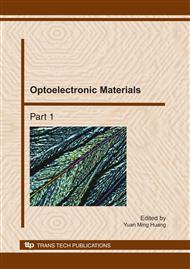p.865
p.871
p.876
p.880
p.883
p.890
p.894
p.898
p.902
Structure and Magnetic Properties of Fe-Doped TiO2 Nano-Crystals by Nonaqueous Synthesis
Abstract:
Ti1-xFexO2 nanocrystals with x = 0.01, 0.02, 0.03 were prepared via a nonaqueous synthesis route. X-ray diffraction, transmission electron microscopy and high resolution transmission electron microscopy characterization confirmed the formation of anatase-phase nanocrystals with the average crystallite sizes of around 10 nm. The lattice constants alternate with the increase of the Fe content and no iron clusters were generated. X-ray photoelectron spectroscopy measurements showed that the substitutional Fe ions present mainly the valence of +3. The magnetic hysteresis loops measured at room temperature (RT) 300K showed that all the doped samples are atypically ferromagnetic, and the coercivity (Hc) of all the Fe-doping samples is around 0.1 T. An interpretation for the intrinsic RT ferromagnetism is put up based on the free carriers and defects induced interaction between Fe3+ ions.
Info:
Periodical:
Pages:
883-889
Citation:
Online since:
November 2010
Authors:
Price:
Сopyright:
© 2011 Trans Tech Publications Ltd. All Rights Reserved
Share:
Citation:


